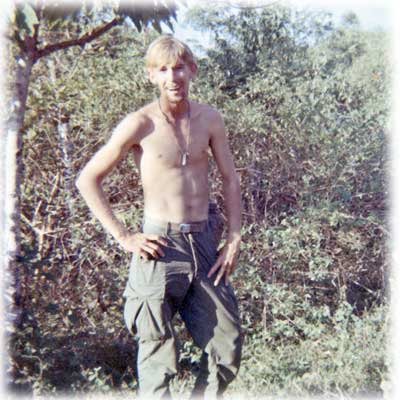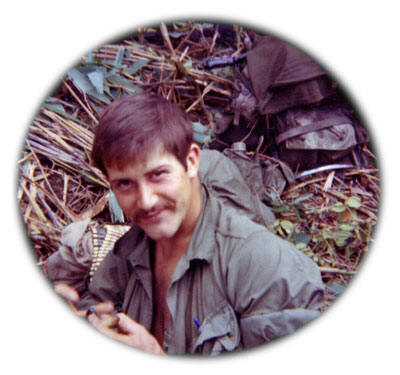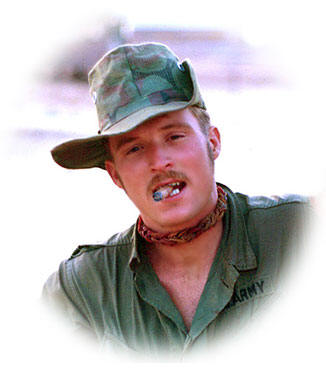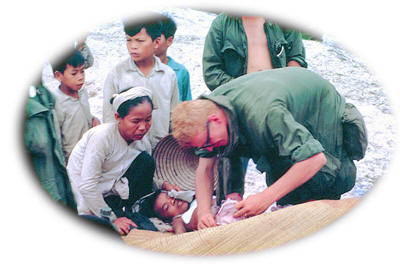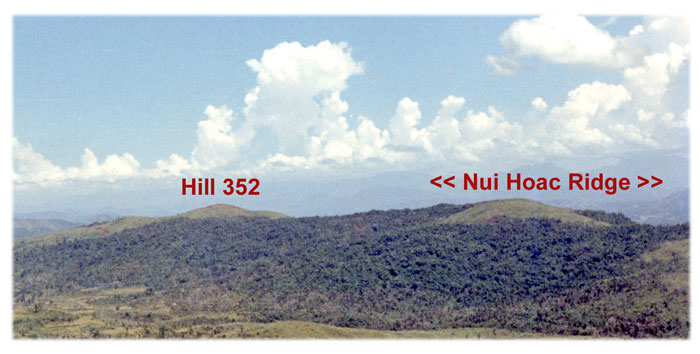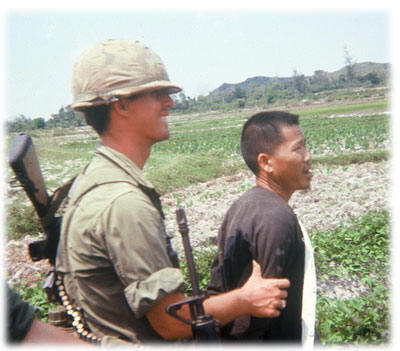|
|
Company A, 1st Battalion, 6th Infantry
|
|
|
Memories 41-50 from Alan Allen
Rifleman, Fire Team A, 1st Squad, 1st Platoon, Company A
|
|
|
41. SPEED's RADIO
We were on our way back to LZ Ross and came to a huge field with a few trees and a small, dry creek. First, second and third platoons were spread out all over it. Fourth platoon, or weapons platoon, was set up somewhere nearby, with their mortars aimed at strategic coordinates along our course, in case we needed their heavier firepower.
We had stopped for a
long noon break. Bill "Speed" Palmer, from
Transistor radios were
handy back then, because
Not long afterwards,
back at LZ Center, Palmer's best friend, Bill Pohl, was killed. Years later
Palmer would tell me he'd cried many night remembering Pohl and Stading being
killed, and me being wounded severely. |
|
42. BACK TO CENTER
On the morning of 8 May 1968, Company A was moved from LZ Ross into the area west-southwest of LZ Center. It was just a few days after Stading died that we walked back onto LZ Center via the southwest quadrant, an area we'd never climbed before. The enemy units operating in the area were elements of the 3rd NVA Regiment, 2nd NVA Division.
The days before had been bitches in a row...lots of gooks, lots of shooting, thanks to LBJ, and, to top it off, two corpses laying just down the hill from the bunkers on Center. They'd been lying there some time. It looked like Tales From The Crypt. Other than bones only skin remained and it hung in strips from the ribs. Their NVA uniforms were mostly rotted away with their flesh. The Red Chinese belt buckles most NVA wore were prized by everyone, and I noted that one of the dead was wearing two and the other one. But when someone asked if I was going to get them, even though there appeared to be no booby-traps, I said I'd pass. A few seconds later I could hear some of the new recruits puking at the smell.
Rotten human flesh smells worse than burning human flesh, but there's something about the idea of the burning and the combo of the smell that makes it seem worse. Believe me, neither one is that conducive to eating, so save your peaches and poundcake for some other day. |
|
43. CARTER’S UNBROKEN LEG
After Stading got
killed Carter was continually bitching about being in Vietnam. Now
we regular-bitched a lot, but once
Stading was dead Carter's bitching became almost continuous. I was tired of
his bitching, but at the same time felt sorry for him--sorry for all of us.
Out of those feelings I hit on a plan. I asked Carter if he really, really
wanted to go home.
"Damn right," he said, so I laid out my plan.
I'd seen a piece of 4"x4" oak lumber behind the bunker that I thought would work. It was like fate had put it there. Usually a piece of lumber like that was too prized to be left lying around. But there it was, right behind our bunker. It was about six feet long --not so long that I couldn't swing it with some authority or guide it with accuracy and it wasn't too heavy-- but was heavy enough that once I got it moving its momentum should carry quite a wallop. I told Carter I could break his leg with it.
Carter was dubious at first, but I explained that we'd lay the bone of his leg over two big rocks, so there'd be little meat to be a cushion between the bone and the rocks. I'd swing the 4x4 down with all my might on his leg bone at a spot between the rocks. Hopefully the bone would be pushed into the space below the leg and between the rocks and snap. He'd be on his way home in no time.
I think that back in the world I'd have never even thought of trying such a thing. If I had, I'd have decided not to go through with it, or would have planned it but chickened out at the last minute. Or, at worst, I'd have hit Carter's leg a half-hearted blow. But in Vietnam you see things differently.
We waited until the heat of the day when almost everyone was inside the relative coolness of their bunker. We set up two small boulders and Carter got into position. I got the 4x4 at the ready, looked around to be sure no one could see, and laid the beam over a shoulder. I swung it up and over my head, then down, with all my strength. As the top portion went down I tried to push on it with one hand, to add weight to the momentum.
I made sure to turn the beam so that one of its four edges would hit the bone initially, thinking that would increase our chances for a break. The oak hit Carter's leg with an awful force.
"God damn," he yelled, jumping up, bouncing on one foot among the boulders and up the hill, "that hurt! Shit!" He yelled so loud guys began sticking their heads out of their bunkers and looking our way, so I dropped the 4x4.
"Did I break it?" I asked in a guttural whisper.
"Hell no, you fucking idiot!," he impolitely replied.
He wouldn't let me try again either, or go for an arm bone--even though I told him that on second thought an arm bone might be the way to go.
But he did quit bitching for a while. |
|
44. POHL
We spent a few shitty
days on Center doing nothing but thinking about the place we were stuck in
and hiding in the sandbag bunkers from the heat by day, and pulling guard
duty at night. (It beat the hell out of humping the boonies, and was much,
MUCH safer.)
At noon on May 13, Bill
Pohl (
I'd been through so much already it seemed shamefully easy to keep Pohl’s death from affecting me. He was gone, out of ‘Nam, and if I didn't think about him, he just wouldn't exist any more. I didn’t want to hurt again the way it hurt when Stading died.
Pohl’s death drove home the fact that you can be here one second and gone the next. And I think that because I lost so many friends I now appreciate my time with people. I don’t hesitate to tell someone I love them now, or like them, or admire them, because they may die before you see them again. |
|
45. DOC FINTON
Thirty-five years after
Pohl was killed Don Kaiser (3rd Platoon) and I were still trying to locate
people from our old company. I finally found Steve “Doc” Finton in his
hometown,
I couldn’t remember Doc’s
last name, and no one else knew either--so, I couldn’t look for him on the
internet. In desperation, I looked up public facilities in
A couple of days later Doc calls me on the phone wanting to know how I knew which church he attended. (He didn’t realize I barely remembered his hometown.) The church secretary e-mailed me that he was very excited to hear from me, as I was to find him. I think she was almost as excited as Doc and I, and was especially happy she'd helped get us back together.
After Doc Finton got in touch with me, he mentioned that he had some photos that belonged to Bill Pohl, and sent copies to me. |
|
46. LT. MENCONI
On May 11, 1968, we walked off Center on a patrol to the northeast. I'll never forget that Lt. William Lee Menconi, from Central Falls, RI, had a bounce in his walk that day, and a smile on his face. He had asked and gotten permission to walk point, something most officers never did...in fact, he's one of two officers I know who ever did it in Alpha Company. Sgt. Bartley is the only one of our "older" NCOs I ever saw do it. Bartley did it a lot, and he was good. I was very jealous of 3rd platoon that they had him. I liked walking point, but I would have been glad to let him take my place. He’d already been to Vietnam, and he knew what he was doing.
Later that morning Lt. Menconi walked into an ambush and was killed. He walked up on the “corner” of an “L-shaped” ambush. The gooks had set it up on a trail bordered on both sides by brush, and situated down in a small, steep-sided valley--more of a ravine really.
There wasn't enough cover by the trail at the "L", so the gook positioned there cut a small evergreen tree and stuck it in a hole right by the trail and his foxhole. I figure Menconi was
likely holding the limbs back to get by that evergreen when he came
face-to-face with that NVA holding a machinegun. He died shortly thereafter.
The machine-gunner got away, but one gook was killed and an AK-47 captured. |
|
47. ELEVEN BODIES
While the company waited for a MedEvac to take Marconi’s body, Sgt. Sherwin Hall, Kirby Heath and I eased down the trail to see what we could see. We found 11 dead Americans from D Company 1st BN 6the Infantry who had walked into the ambush earlier, but from the other end of the ravine.
Looking at the blackened, bloated bodies, I guessed they'd been killed a few days before. I've always wondered why no one had come looking for their remains--but maybe that was part of our job that day. I wouldn’t know, nobody ever told us much.
About halfway down the line of bodies Hall came to a trail that went up the side of the ravine to the left. He turned up it to investigate, with Heath right behind him, then me. As we neared the crown of the hill a gook rose up about 15 feet away on our left and tossed a homemade "Chicom" (Chinese Communist) grenade. I saw it spinning in slow motion through the air, a thin trail of smoke making a corkscrew spiral as it turned end-over-end. I could even read what was written on it, as it made each turn, as plain as day, "7-Up, 7-Up, 7-Up…"
The enemy used whatever was available to make booby traps, grenades and other stuff to hurt American soldiers. I've seen grenades made out of Coke cans and other soft drinks, as well as beer cans. This one just happened to be contained in a 7-Up can.
We all three looked up at it for a split second. Ah! The pause that refreshes. Then Hall and Heath ran smack-dab over me as I vacated the place as best I could. We went back to where Lt. Menconi had been killed. The powers that be decided to pull out of the little valley and change tactics.
We left the ambush site and within minutes an F-14 jet arrived. We popped smoke (fired a smoke grenade) to mark our position, so he wouldn't kill us by mistake. The pilot then dropped a couple of napalm bombs right on the bodies of the dead Americans. He made two runs only about 200 yards from us, and since we had climbed onto a small hill, he released the bombs at about eye-level...it was impressive when the flames belched up out of the little valley. We were close enough to feel the heat.
I've often wondered if
those folks with the black plastic body bags ever went out there and zipped
those bodies up back then. Or did the Army mark the location, so they'd know
where to look in case they were allowed to reclaim the bodies after the war?
Or did they just tell those guys' mother and father and brother and sister
and grandparents, "Oops, 11 more 'Missing in Action.'"? |
|
48. HILL 352 (NUI HOAC RIDGE)
I'm proud to have
served with a winner of the Congressional Medal of Honor, SFC Finnis Dawson
McCleery. A fellow Texan, he was born Christmas Day in Stephenville, and died
July 11, 2002, in
We were in the Quang Tin Province, 17 miles west of Tam Ky, when McCleery led his men up Hill 352 and across an open area to close with the enemy. His 1st Platoon and other friendly elements were pinned down by tremendously heavy fire coming from fortified enemy positions. Realizing the severe damage that the enemy could inflict if the attack was completely halted, Platoon Sgt. McCleery rose from his sheltered position and began a one-man assault on several bunkers.
With extraordinary courage, he moved across 60 meters of open ground as bullets struck all around him and rockets and grenades literally exploded at his feet. As he came within 30 meters of the key enemy bunker, McCleery began firing furiously from the hip and throwing hand grenades. At this point in his assault, he was painfully wounded by shrapnel, but, with complete disregard for his wound, he continued his advance on the key bunker and killed all of its occupants.
Having successfully and single-handedly breached the enemy perimeter, he climbed to the top of the bunker he had just captured and, in full view of the enemy, shouted encouragement to his men to follow his assault. As the friendly forces moved forward, McCleery began a lateral assault on the enemy bunker line to his right. He continued to expose himself to the intense enemy fire as he moved from bunker to bunker, destroying each in turn. He was wounded a second time by shrapnel as he destroyed and routed the enemy from the hill.
P/Sgt. McCleery is personally credited with eliminating several key enemy positions and inspiring the assault that resulted in gaining control of Hill 352.
I was a squad or two back down the line of men snaking up Hill 352 when I heard the shooting begin. I couldn't stand not being up there, so I told my squad leader I was going to see what was happening.
As I ran up near the edge of the top of the hill, I saw Sgt. McCleery take a bunker and call for us to follow him. As he moved to his right to take on another bunker, I moved to my left to take on another bunker along the line of the enemy perimeter.
Things just sort of fell into place. As I approached the first bunker an NVA stood up and tossed a grenade at me. I ran back a few feet and hunkered down with my back to the grenade. As soon as it exploded I turned, pointed my shotgun at the spot where the NVA had been, and advanced towards him. When he stood with another grenade I pulled my trigger. He went down, with his hair blown back from his face; his grenade exploded, and I ran up and tossed my own grenade into the hole in order to kill the other guy in the bunker.
At the next bunker I was ready. When the NVA stood I shot him with my shotgun before he could fire at me. I then tossed a grenade in his bunker.
The next was a foxhole and I shot the NVA when he aimed his AK-47 at me. I had already pulled the pin on a grenade, and had dropped the pin. So I ran back to a bomb crater, where some guys from 3rd Platoon had taken cover. Bruce Metz was there, with eyes as wide as I imagined mine were. I tried to hand him the grenade.
"Metz, take this, I don't have a pin," I said.
Wisely, as I think back on it, he refused to take the grenade.
"Come on man," I said, "I've got to go. Take it!"
Finally,
I went back to the active part of the enemy perimeter and took another bunker. When I got to the main bunker in the center of their perimeter, I was out of grenades. It was weird, but as I stood looking down on the top of the Command Post, a hand came out a hole in the top holding an RPG round. I guess the NVA wanted me to shoot at him, explode the round, and kill us both. Or, maybe he thought I wouldn't shoot while he held the round.
Regardless, a Mexican
guy, I think from 3rd Platoon, came up. He asked me to hold my shotgun on the
hole while he tossed in a grenade. I did, and their CP was closed for
business. |
|
49. MEDALS
I remember later that
evening Sgt. Hall evidently was writing some of us up for medals for what
we'd done that day. He asked me how many NVA I'd killed, and I thought it was
11. I'd probably taken four or five bunkers, plus their CP. I later received
the Silver Star for Hill 352, and the medal was given me while I was in the
bed at Beach Pavilion in Brooke Army Medical Hospital in
I also asked Hall to put me in for my second Purple Heart. I didn't realize it until the fighting was over, but I had a chunk of ChiCom grenade stuck in my right hand.
We stayed right there on the Hill that night. After we'd gone out and set up trip flares and Claymore mines among the NVA bunkers we'd just overrun, we settled in for another night of guard duty. I remember I was still hyped up over the recent combat. Then, well after dark, but while everyone still was awake and talking in whispers, a trip flare went off; up jumps an NVA, one we'd missed. He'd tried to sneak off down the ridge, tripped a flare, and when the ridge lit up around him he decided to vacate the place.
He leaped and bounded
down the ridge like a rabbit. It was so startling and weird that none of us
fired a shot or set off a Claymore. That was one lucky guy. |
|
50. HACK GETS SHORT
John Hacker, i.e.
“Hack,” from
(Pohl died less than a month before getting to go home and Lt. Love says just days before they were going to pull him out of the field.)
It seemed that when a guy began getting short he either got more scared than he had been, or he got braver than he had been. Hack got braver. I don’t think most men did that.
He was our squad leader, but he told me he wanted to walk point more. His first day on point after getting short, he snuck (East Texas colloquialism) up on three NVA sitting around a campfire. He opened up with his M-16, but only got one.
That evening he came and asked me why he hadn’t gotten them all, so I asked him what he’d done.
“Did you fire on full-automatic?,” I asked. He said he did.
I told him to put his selector switch on semi-automatic, take good aim at one gook and fire until he fell, then move to the next one.
The next day or so Hack
walked up on three NVA, two at a campfire, and one in a hooch. He killed the
two at the fire in-place, and got the third as he tried to escape--he never
made it out of the hooch, and Hacker's tracers set the hooch on fire. The
smell of burning human is something I'll never forget. |
©2007 by Alan Allen, All Rights Reserved
Privacy Policy: Don't give us anything you don't want the world to see. .


